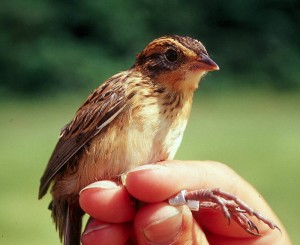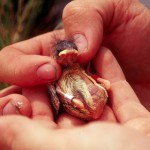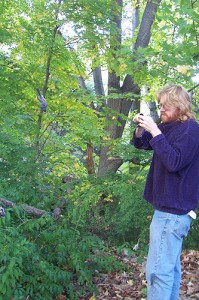
Saltmarsh Sparrows practically blend into the grays and browns of the marshes they inhabit along a narrow fringe of coast in Connecticut and other eastern states.
But as new research by CLAS faculty member Chris Elphick and colleagues shows, these shoreline birds are remarkable for their “extreme levels of multiple mating” and are thought to be the most promiscuous birds in the world.
Elphick’s work was carried out in collaboration with Christopher E. Hill from Coastal Carolina University and Carina Gjerdrum of the Canadian Wildlife Service.
In an article in The Auk, a premier ornithological journal, the scientists describe mating patterns that give new meaning to the term “multiple paternity.”
Fifty-seven out of 60 broods had at least two chicks with different fathers.

At least 97 percent of females were mating with more than one male.
In any one nest, it was impossible to tell who the fathers were of all the chicks without checking DNA.
While most small birds have monogamous relationships, ornithologists say that low levels of “extra-pair mating” happen in many species. Even so, the promiscuity levels seen in Saltmarsh Sparrows are extraordinarily high. Only the Greater Vasa Parrot of Madagascar and the Superb Fairy-Wren of Australia are known to come close.
The researchers didn’t set out to track the sexual habits of the sparrows. But as an offshoot of their long-term research on the birds, funded by Connecticut Sea Grant, the US Environmental Protection Agency, and the Connecticut Department of Environmental Protection, they decided to track whether reports of unusual mating patterns were true.
Elphick, an assistant professor of ecology and evolutionary biology, and Gjerdrum, then an EEB research technician who now works for the Canadian Wildlife Service, collected data on sparrow paternity for two summers in nine marshes along the Connecticut coast.

To do their sparrow research, they catch the birds in fine mesh nets and band them. For this study, they took blood samples to test the birds’ DNA. Chicks in the nest were also sampled.
Chris Hill, a biologist at Coastal Carolina University, did the molecular analyses for the study.
It was easy to determine maternity of the chicks, because the mothers sit on the nests, Elphick says: “The tricky part is the fathers.”
Male Saltmarsh Sparrows take no part in chick rearing, so the only way to associate a male with a brood is to catch all the males in an area and conduct paternity tests.
Easier to figure out was whether the chicks in a nest had the same father, and the DNA analyses showed how rare that was.
The Saltmarsh Sparrows face multiple habitat threats, and their conservation is the focus of Elphick’s research. They live only in a narrow fringe of coastal land from Virginia to Maine, a habitat favored by humans for development and seaside homes.
Their saltmarsh nests are flooded regularly, so many chicks drown. As sea levels rise with global warming, the birds’ very existence is threatened.
But for now, they hold the world’s record for promiscuity in the bird world.
To learn more about Elphick’s research and ornithology at UConn, go to the Ornithology Research Group website.
An abstract of the article is available online at The Auk website, where the full article is also available to subscribers. It will appear in print in April 2010.


